Portraits, Pastels, Prints: Whistler in The Frick Collection
June 2 through August 23, 2009
Pastels | Etchings
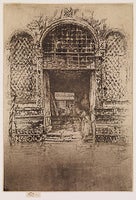 |
|
The Doorway, 1879–80
State IV/VII
Etching and drypoint |
Rush-bottomed chairs hang from the ceiling of a caner’s workshop glimpsed
through a stately fifteenth-century doorway.
Whistler’s use of drypoint between the
grates of the central lunette gives the
darkness a rich, almost glossy quality.
Wavering reflections of the architecture on
the water dissolve into shadow, represented
here with a film of plate tone.
 |
|
Two Doorways, 1879–80
State IV/VII
Etching and drypoint |
In the open doorway at left, thickly massed lines convey deep shadow and obscure the
contours of the space. Whistler describes
the brickwork beneath the crumbling
façade with staccato strokes. A gondolier
silhouetted against the palaces at right
draws the eye around the corner and into
the light.
 |
|
The Mast, 1879–80
State V/VI
Etching and drypoint |
Here a dramatic swoop of line leads the eye to the top of the pole, where the
winged lion of Saint Mark — the symbol
of the city — features prominently against
the bare sky. On feast days this mast flew
the standard of Santa Marta, the patron
saint of this working-class neighborhood.
In the foreground Whistler depicts women
making lace, while a fisherman displays his
daily catch at right.
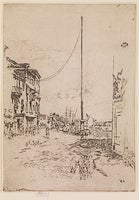 |
|
The Little Mast, 1879–80
State I/IV
Etching and drypoint |
Whistler leaves the upper story of the building at right incomplete, allowing the
mast to dominate the print’s top register.
In contrast to the neighboring etching,
the expressions of the children in the
foreground are blank, their forms rendered
in a masterful shorthand.
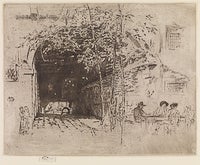 |
|
The Traghetto, No. 2, 1879–80
State IV/VI
Etching and drypoint |
Off-duty boatmen relax outside a passageway connecting the street with
a traghetto landing seen at the archway’s
end. The deep diagonal recession is partly
screened by three trees. Like the sprays
of bamboo and plum blossoms Whistler
incorporated into many of his paintings, the
leaves and branches here function as devices
for the playful manipulation of space.
 |
|
The Beggars, 1879–80
State IV/IX
Etching and drypoint |
Here a barefoot young girl directly confronts the viewer while her older
companion stares into space. Whistler
reworked this pair and the spectral middle
figure several times, and experimented with
wiping ink from and around their forms
to set light figures against a dark ground,
and vice versa. Enriching his etched lines
with drypoint and plate tone, he wraps the
foreground figures in heavy shadow.
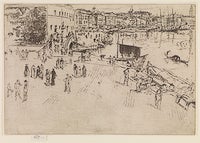 |
|
The Riva, No. 1, 1879–80
State III/IIIa
Etching and drypoint |
The high vantage point of this scene suggests that Whistler took the view from a window
in his lodgings on the Riva degli Schiavoni.
To show the bustling activity below, the
artist flattens the foreground space, while
allowing the row of buildings to recede to
the horizon. The domes and campanile of
the basilica of San Marco appear just above
the rooftops at the far right.
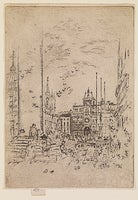 |
|
The Piazzetta, 1879–80
State IV/V
Etching |
Demonstrating a characteristic preference
for unconventional viewpoints, Whistler
presents the façade of San Marco partially
obstructed by the column of San Teodoro.
Figures relaxing on its base provide a
counterpoint to the animated groups of
people and pigeons in the square. As in
almost all the etchings of the First Venice
Set, Whistler incorporates his butterfly
signature — here to the left of the figure
leaning against the column.
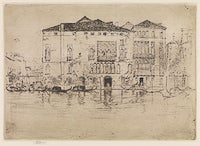 |
|
The Palaces, 1879–80
State II/III
Etching and drypoint |
Whistler’s subjects are the Palazzo Sagredo,
which Ruskin admired for its graceful
Gothic architecture, and the Palazzo
Pesaro, at right. Though his nonspecific
title downplays the significance of these
structures, Whistler lavishes attention on
the elegant ornamentation of their façades.
He leaves large areas in the sky, upper
stories, and water untouched by the etching
needle to convey the brightness of midday.
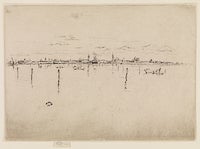 |
|
Little Venice, 1879–80
Only state
Etching and drypoint |
Here the waters of the inner lagoon and
the city’s most recognizable monuments —
such as the church of San Giorgio and the
Palazzo Ducale — are inscribed within a
narrow section of the plate, demonstrating
Whistler’s ability to describe a view with
the utmost economy. Dark plate tone
at the bottom of the print provides a
visual anchor for this fleeting view of the “floating” city.
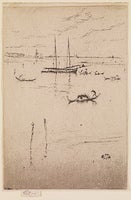 |
|
Little Lagoon, 1879–80
State II/II
Etching and drypoint |
Like Little Venice, this etching represents
the more delicate end of Whistler’s
technical spectrum. A series of paired
vertical elements — mooring posts, masts,
and their reflections — structure the steep
composition, leading the eye toward the
high horizon. With its spatial compression
and asymmetrical arrangement of forms,
this work reveals Whistler’s admiration for
Japanese woodblock prints.
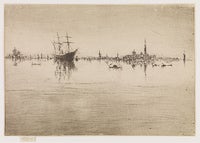 |
|
Nocturne, 1879–80
State III/V
Etching and drypoint |
Whistler’s ability to convey different effects
of light in a monochromatic medium is
on full display in this remarkable etching.
Strong plate tone at top and bottom
suggests a darkening evening sky reflected
in the water below, while faint lines
indicate gas lanterns suspended on the
deck of the steamship and along the shore.
Whistler dissolves the outlines of the ships
and structures on the horizon, building
both form and reflection with single strokes
of the etching needle. |


